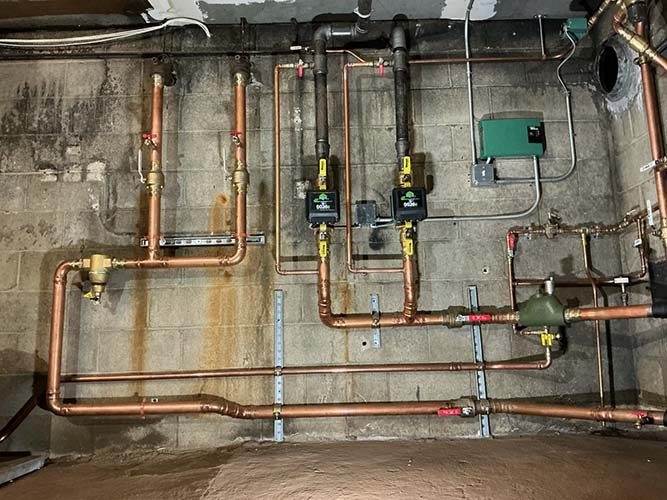
Switching Lanes
Contractors complete oil-to-gas conversion for Connecticut apartment building.
Dan Scher doesn’t back off from construction challenges. He certainly found one in an oil-to-gas heating conversion for an aging multifamily apartment building in Connecticut.
Scher, a New York-based contractor specializing in HVAC installation and repair, needed to complete the conversion for an 18-unit, three-story complex in Norwalk, Connecticut. The 10,800-square-foot building was built in 1967 and was purchased in April 2024 by a new owner.
A boiler serving the units with heat and hot water had been leaking. Scher developed a plan that maintained service to the residents while installing a new boiler and indirect water heater and simultaneously switching from oil to gas.
Plan development
Scher’s plan for the conversion became rooted in his experience as a general contractor early in his professional career. He worked with David Viera of Absolute Cooling and Heating in coordinating all aspects of the heating transition.
“As a general contractor, I was in charge of setting up the job and making sure all the trades were doing what they were supposed to,’’ Scher explains. “Coordination is a big thing. I’ve always gravitated toward mechanical problems, and often it was easier to send me back in to complete the repair. I’m a big fan of learning and going to classes, and when I decided to have a specialty, I kept working at it.”
The leaky boiler needed repair, but the process did not begin in earnest until workers established a gas line to the building. Between permitting and installation, that process required nearly four months to complete. As that played out, Scher studied the layout of the apartments and mechanical footprint to determine how to proceed.
“We knew we had to do a switch over in a short period,” he notes. “The existing boilers had to stay in place, so we needed to work around them. When we did tie into the heating side, it needed to be done quickly because we couldn’t allow too much downtime with heat to the apartments.”
Scher and his crew routed piping around existing construction and equipment and went to work on installing the new mechanicals. “We had to make sure the new system would function properly and not have any issues in the future,” he says. “We couldn’t go back and cut out anything later on. Planning is the only way to get around an issue like that.”
Making the switch
Like several other New England states, heating oil is the dominant energy source for many homes and some smaller apartment buildings. In Maine, 59% of households use heating oil, according to the Energy Institute (https://bit.ly/3WIMx2W). Approximately 39% of Connecticut households use heating oil.
Oil prices, however, can fluctuate wildly and the commodity is more expensive than natural gas or electricity. Oil-fired systems also require frequent maintenance and the environmental impact — burning oil produces greenhouse gases — is noncompliant with current trends.
While converting to gas can be costly, the change will save money over time. Natural gas is far less costly than heating oil — fuel oil is nearly double the cost of natural gas — and it is the cleanest fossil fuel available for heating.
For the apartment project, Scher needed to install a water heater that could deliver hot water to each apartment while also offering long-term dependability.
Hot water solution
Scher selected HTP’s SuperStor Ultra 80-gallon model for the project. The indirect unit is one of the most cost-effective ways to heat water, as it eliminates the flue losses associated with gas-fired storage water heaters and the additional costs and unreliability of tankless systems.
Since all 18 apartments rely on the water heater, Scher wanted a model that could store hot water up to 180 degrees with a mixing valve set to 110 degrees.
“That essentially increases the capacity of the tank and helps the hot water last longer,” he explains. “You’re only using three-quarters of the actual stored water in the apartment. The efficiency of the boiler also allows for the recovery to be higher.”
The HTP SuperStor Ultra includes a 316L stainless-steel tank that resists corrosion and eliminates the need for an anode rod, which makes the system virtually maintenance-free. Hot boiler water flows through an internal heat exchanger in the tank. The cupronickel heat exchanger includes 11.5 fins/inch of tube to maximize efficiency. It provides up to 50% more hot water than water heaters of a similar size.
“The 80-gallon tank will be adequately sized for residents of the apartments,” Scher notes. “If each apartment had its own washing machine, the load on the water tank would change and that would have to be considered in choosing the size of the tank. In this case, the apartments don’t have their own washers; there’s a separate laundry room. There are only a few dishwashers. That allows for the load on the water heater to be a lot less.”
Smooth transition
The transition from oil to gas in the multifamily unit went smoothly. In a little more than a day, Scher and his team successfully completed the changeover. Residents were without heat for a limited time, and well before harsh winter weather gripped the region.
The transformation is similar to Scher’s career, where he now owns his own business and focuses on his own clients instead of working for a large company.
“I distinguish myself by being reliable, honest and doing the best job that I can,’’ he says. “All the work I get is usually from referrals. Ultimately, you have to stand by what you do. The way I’ve been able to get work is by doing the right thing for my customers.”
Thomas Renner writes on building, construction and other trade industry topics for publications throughout the United States.
